Jubaeopsis caffra
Jubaeopsis caffra Becc.
Family: Arecaceae
Common names: Pondo coconut, Pondo palm (Eng.); Pondopalm (Afr.); ikomba (isiXhosa) National Tree List no. 27 in South Africa.
SA Tree No: 27
Introduction
A South African palm whose nearest living relative grows in Chile (South America), sounds like fiction, but it is not. Here it is.

Description
Description
Evergreen tree to 5(-8) m tall. Bark grey, rough, adhering. Stems round, unarmed. Leaves alternate, pinnate, 3-4 m long; petioles 400-600 mm long, hairless. Leaflet blade 250-500 mm long, 8-26 mm wide, linear; apices narrowly pointed; surface glossy; veins hairless; margin without teeth. Inflorescence an axillary, erect panicle. Pedicels 0. Perianth consisting of a calyx and corolla. Flower radially symmetrical. Petals and sepals unequal in size. Calyx of 3 free, triangular, creamy sepals. Corolla of 3 free, ovate, white or creamy to green petals, without markings.
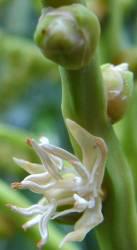
Plants with separate male and female flowers, arranged with two males flanking each female. Stamens (7-)8-16. Ovary superior, 3-locular. Styles 3. Fruit a round, hairless berry 20-40 mm long, 20-42 mm in diameter; rind smooth, leathery, orange. Seeds dark brown.
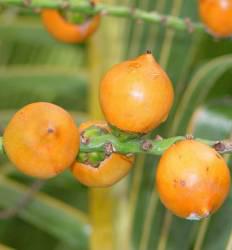
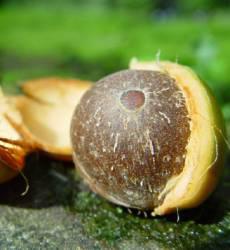
Among South African palms ours is most similar to the wild date (Phoenix reclinata) when not in fruit. Two easily observed leaf characters serve to separate them, however. Firstly, the lowest leaflets of a date palm leaf are hardened into prickles, but in the Pondo palm they are soft. Second, although as in most palms the leaflets are folded into a V, the fold in the middle points down in a date, and up in the Pondo palm.
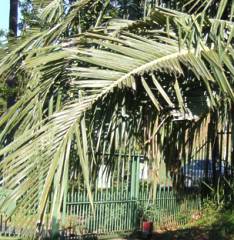
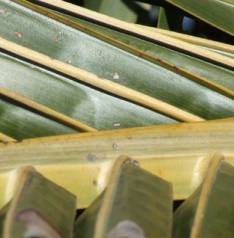
Conservation Status
Status
Raimondo et al. (2009) list this palm as Endangered, due to limited distribution and small population size. It is threatened by over-exploitation of the fruits as a food source, and harvesting for the horticultural trade. However it seems that vegetative reproduction is at present maintaining the natural population of adult individuals.
Distribution and habitat
Distribution description
The Pondo palm grows naturally on the banks of two rivers, only one in a protected area, in the Eastern Cape. In cultivation, it is occasionally seen on the south coast of KwaZulu-Natal, as far north as Durban. As it is restricted in nature to Natal-group Sandstone, it must be considered to be one of several trees only known from the Pondoland Centre of Endemism.
Derivation of name and historical aspects
History
It appears that this palm was first noted scientifically in 1898, but the first published account of its unusual characters was by Sim (1907), almost 10 years later. Only in 1913 did someone send specimens to the then leading world expert on palms, Odoardo Beccari, in Florence (Italy). He described it as a new genus, and placed it near Cocos, the genus to which the coconut belongs. The most recent revision (Glassman 1987) accepts this placement essentially unchanged, though it has been confirmed that the nearest living relative of our palm is Jubaea chilensis (Molina) Baill., the Chilean wine palm. These two genera include only one species each.
The name Jubaea commemorates King Juba (d. 46 BC) of Numidia, North Africa. The reason for selecting such a name for a South American palm is obscure. The name of our genus commemorates its resemblance to Jubaea chilensis by adding the Greek suffix -opsis (meaning `looks like') to the South American genus name. As late as the early 19th century, the specific epithet meant no more than `from south-eastern Africa'. It is mildly surprising to find it used for a new species as late as 1913, by which time it had already begun to acquire the pejorative overtones which have now completely displaced the original and intended meaning.
Ecology
Ecology
The two palms most heavily used for nesting material by the local weaver birds in the area of Durban around the KwaZulu-Natal herbarium are our Pondo coconut and the wild date (Phoenix reclinata ). For this reason our cultivated tree seldom looks its best.
Williams (1991) notes that the male flowers in each group release their pollen before the female in that group is receptive. In most plants this is an adaptation to ensure outbreeding (so that the plant will usually not fertilise itself). There is no record of how the pollen is transferred to a female flower, though in many palms the flowers emit a scent which attracts a wide variety of insects. Similarly, the animal which carries the seeds from one site to another is unknown, though, as Boon (2010) reports that baboons as well as people eat the seeds, they must be regarded as possible vectors. In nature a significant part of each seed crop falls into the salty water in river estuaries, and it is known that they do not survive such immersion for more than a few minutes.
This palm is one of the trees which provides a perch for the rare epiphyte Dermatobotrys saundersii.
Uses
Use
As mentioned above under Conservation, the only known uses of this rare palm are as a very local food source and for horticulture. Because of the threat to the continued existence of the species that both of these pose, neither should be encouraged. However, Boon (2010) notes that in California this species has been propagated from a relatively small number of `founder' seeds with such success that they can use it as a street tree.
Growing Jubaeopsis caffra
Grow
In view of the limited natural population, which is already threatened by over-exploitation for horticulture, the single most important piece of advice for would-be growers of this palm is DON'T! The tree is protected and there is no legal source of seed. Seedlings are almost certainly raised illegally too, and one should not buy them without written guarantees of permission to possess them.
That said, the tree in the grounds of the KwaZulu-Natal Herbarium makes a very attractive feature of our garden. It evidently likes our warm, moist climate and sandy soil. With the possible exception of the resident weaver birds (see the section on ecology above) and occasional scientists from the University, we have seen no parasites on the tree, and smaller pests and diseases are unknown. It is, however, known that for some reason seeds do not germinate easily, and in experimental plantings in this country germination rates have always been low.
References
- Boon, R. 2010. Pooley's Trees of eastern South Africa. Flora & Fauna Publications Trust, Durban.
- Coates Palgrave, M. 2002. Keith Coates Palgrave's Trees of southern Africa. Struik, Cape Town.
- Glassman, S.F. 1987. Revisions of the palm genus Syagrus Mart. and other selected genera of the Cocos alliance. Illinois Biological Monographs 56: 1-230.
- Glen, H.F. 2004. SAPPI What's in a name? Jacana, Johannesburg.
- Palmer, E. & Pitman, N. 1973. Trees of southern Africa. Balkema, Cape Town.
- Raimondo, D., Von Staden, L., Foden, W., Victor, J.E., Helme, N.A., Turner, R.C., Kamundi, D.A. & Manyama, P.A. (2009). Red List of South African Plants 2009. Strelitzia 25. South African National Biodiversity Institute, Pretoria.
- Sim, T.R. 1907. The Forests and Forest Flora of the colony of the Cape of Good Hope. Taylor & Henderson, Aberdeen.
- Van Wyk, A.E., Van den Berg, E., Coates Palgrave, M. & Jordaan, M. 2011. Dictionary of names for southern African trees. Briza Academic, Pretoria.
- Wicht, H. 1969. The indigenous palms of South Africa. Timmins, Cape Town.
- Williams, R. 1991. Jubaeopsis caffra. The Flowering Plants of Africa 51: t. 2023.
Credits
H.F. Glen
Kwazulu-Natal Herbarium
July 2011
Plant Attributes:
Plant Type: Tree
SA Distribution: Eastern Cape
Soil type: Sandy, Clay, Loam, Brack/saline
Flowering season:
PH: Acid, Alkaline, Neutral
Flower colour:
Aspect: Full Sun, Shade
Gardening skill: Average
Special Features:
Horticultural zones








Rate this article
Article well written and informative
Rate this plant
Is this an interesting plant?
User Comments
ANGELA SILVIA COSTA DE PAULA, Brazil
March 09, 2016 at 4:24 AMHello
A few years ago I won a researcher seedlings of a palm tree, planted, she grew up and was beautiful and very large. I searched in my country, Brazil, and realized that she was exotic. I spent years looking for and I think I found in a libro, PALMS AND cycads - David Squire, my palm it was a jubaeopsis caffra. Also, I checked here at Sandi that my kind corresponds at all to this beautiful South African palm, except for one feature, the leaves have small spines on the margin. In the description here and also in the description of PALMWEB site, states that the palm leaves have teeth.
I would like, if possible, to help me in this confirmation. For this, attached photos of Palm, details such as leaves, stems. She has planted 12 years and still has not given flowers or fruit. Thank you for your attention and help.
Best regards
Angela Paula
Alice Notten
March 17, 2016 at 9:34 AMThank you for your comment and photos Angela Paula. We love to see South Africa's plants thriving far from home.
The PlantZAfrica Team think that your palm is Raphia australis. The trunk of your palm does not look similar to the trunk of the Jubaeopsis in the Durban Botanic Garden but does look like that of the Raphia. Also, Raphia has spines along the edge of the leaflets and on the upper surface of the midrib whereas the Jubaeopsis leaves are without spines.
The surest confirmation of identification will come when your palm flowers and produces fruits or “seeds”. If they are round and yellow and smooth then it is a Jubaeopsis, but if they are oval, mahogany brown and covered with overlapping scales then it is a Raphia. (see Raphia fruits on this page http://pza.sanbi.org/raphia-australis)
Futhermore, Raphia australis palms have a shorter lifespan, they live for about 25 years then they send up a massive branched flower spike, which sets fruit and then the palm dies, whereas the Jubaeopsis does not die after it flowers and sets fruit.
Bruce Robertson, South Africa
August 26, 2019 at 2:52 PMI published my PhD thesis on Jubaeopsis caffra in 1975 (University of Port Elizabeth). The results of my work were widely published in the '80s - including distribution, morphology, embryology, fruit development, growth, seed germination etc. The best example of a cultivated specimen is in St George's Park in Port Elizabeth - which is now ca. 100 years old.
Login to add your Comment
Back to topNot registered yet? Click here to register.